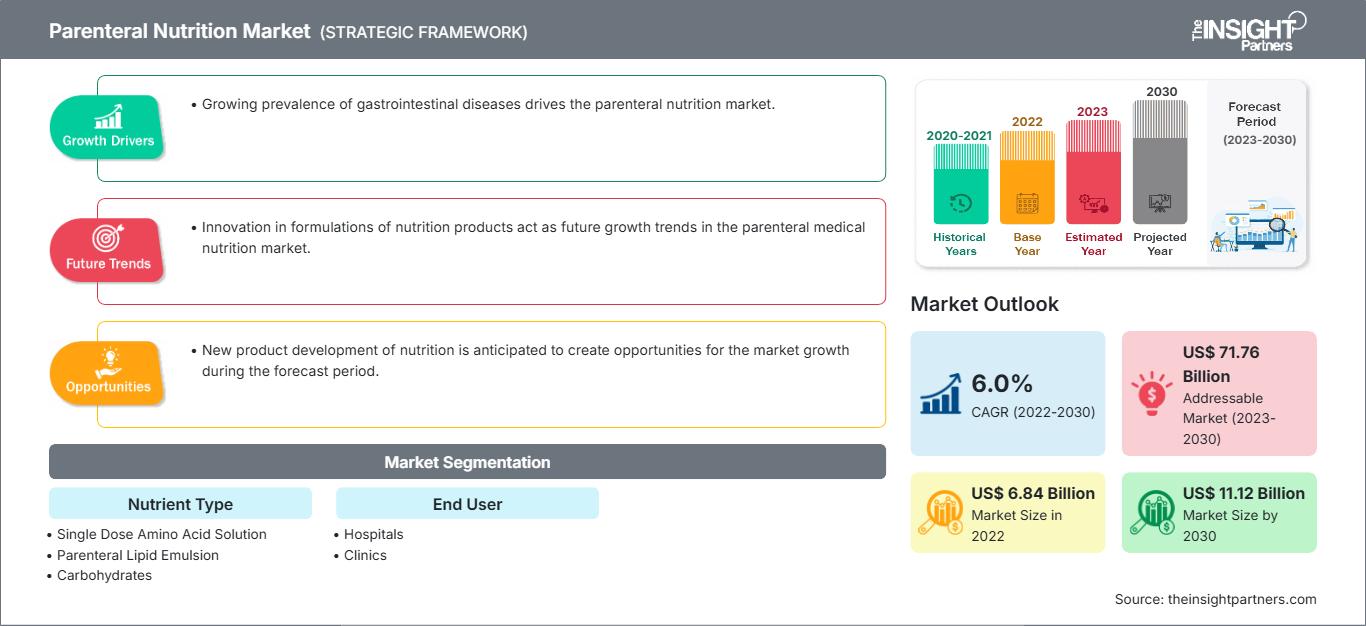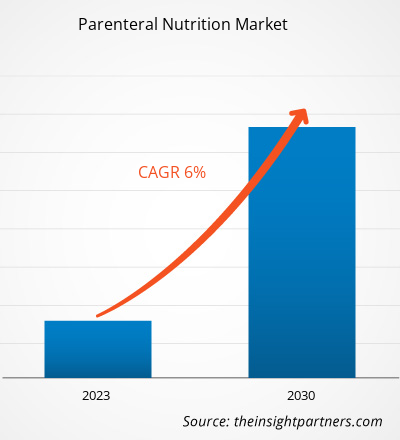非経口栄養市場規模は、2022年の68億4,000万米ドルから、2030年には111億2,000万米ドルに達すると予測されています。市場は2022年から2030年にかけて6.0%のCAGRを記録すると予想されています。栄養製品の配合におけるイノベーションは、この市場の重要なトレンドであり続けるでしょう。
非経口栄養市場分析
胃腸疾患の罹患率の上昇、栄養失調および早産の急増は、市場発展の主要な推進要因です。さらに、栄養製品の配合におけるイノベーションは、非経口栄養市場のプレーヤーにとって重要なビジネスチャンスです。
非経口栄養市場の概要
クローン病、腸閉塞、潰瘍性大腸炎、短腸症候群、顕微鏡的大腸炎、胃がんは、胃腸疾患の例です。 2021年1月に発表された「世界における機能性胃腸疾患の有病率と負担:ローマ財団グローバルスタディの結果」によると、機能性胃腸疾患は世界人口の40%以上に影響を与えています。2019年の世界疾病負担調査によると、2019年には世界中で約490万件の炎症性腸疾患(IBD)が記録されました。中国(911,405件)と米国(762,890件)の症例数が最も多く、それぞれ人口10万人あたり66.9件と245.3件の有病率でした。潰瘍性大腸炎とクローン病は、一般的に診断されるIBDの2つです。クローン病は、主に消化器系に影響を与える複雑な慢性疾患であり、北米とヨーロッパで最も一般的な疾患です。
要件に合わせてレポートをカスタマイズ
レポートの一部、国レベルの分析、Excelデータパックなどを含め、スタートアップ&大学向けに特別オファーや割引もご利用いただけます(無償)
非経口栄養市場: 戦略的洞察

-
このレポートの主要な市場動向を入手してください。この無料サンプルには、市場動向から見積もりや予測に至るまでのデータ分析が含まれます。
非経口栄養市場の推進要因と機会
栄養失調と早産の急増
栄養失調には、栄養不足、過体重または肥満、ビタミンやミネラルの不足、不健康な食生活による非感染性疾患が含まれます。世界保健機関(WHO)のデータによると、2021年には約19億人の成人が過体重または肥満であり、4億6,200万人が低体重でした。さらに、5歳未満の子供3,900万人が過体重、1億4,900万人が食事における栄養豊富な食品の慢性的な不足の結果として発育障害と発育障害を患い、4,500万人が消耗症(身長に対して痩せすぎ)でした。さらに、5歳未満の子供の死亡の約45%は栄養失調に関連しています。国連児童緊急基金(ユニセフ)の2022年7月のデータによると、栄養不足の蔓延率は2019年の8.0%から2020年には9.3%に達し、2021年にはさらに9.8%に上昇しました。
企業による新製品開発
非経口医療栄養市場で事業を展開している企業は常に新製品の発売に注力しており、それが売上向上に役立ちます。非経口栄養市場における注目すべき開発のいくつかを以下に示します。
- 2022年12月、バクスターインターナショナル社は米国でExactaMix Pro自動調剤装置を発表しました。この発表は、米国医療システム薬剤師会(ASHP)の2022年中間臨床会議で行われました。この製品は2023年の初めに発売されました。最近リリースされた製品は、最先端の配合技術を利用して、患者の安全性、プロセスの有効性、および製剤の精度を向上させています。
- 2022年3月、フレゼニウス カビのSMOFlipid脂質注射用乳剤が米国食品医薬品局(FDA)の承認を取得しました。このエマルジョンは、満期産新生児や早産新生児を含む小児患者に非経口栄養を提供するために使用され、非経口栄養を必要とする小児患者向けの最初で唯一の4オイル脂肪乳剤となります。
したがって、栄養の新製品開発は、予測期間中に市場成長の機会を生み出すと予想されます。
非経口栄養市場レポートのセグメンテーション分析
非経口栄養市場分析の導出に貢献した主要なセグメントは、提供、使用法、およびエンドユーザーです。
- 栄養素の種類に基づいて、非経口栄養市場は、単回投与アミノ酸溶液、非経口脂質乳剤、炭水化物、微量元素、ビタミン、ミネラルに分類されます。単回投与アミノ酸溶液セグメントは、2022年に最も重要な市場シェアを占めました。
- エンドユーザーに基づいて、非経口栄養市場は、病院、診療所、その他に分類されます。病院セグメントは2022年に最大の市場シェアを占めました。
非経口栄養市場の地域別シェア分析
非経口栄養市場レポートの地理的範囲は、主に北米、アジア太平洋、ヨーロッパ、中東およびアフリカ、南米および中米の5つの地域に分かれています。
北米では、米国の非経口栄養市場が地域で最大のシェアを占めています。がん、心臓病、その他の慢性疾患は、米国における障害と死亡の主な原因です。国立慢性疾患予防・健康増進センターによると、国内の10人中6人が少なくとも1つの慢性疾患と診断されています。さらに、米国病院協会は、約1億3,300万人が少なくとも1つの慢性疾患を患っていると推定しており、その数は2030年までに1億7,000万人に達すると予想されています。米国では、年間平均約34,000人の患者が経腸栄養(PN)を受けています。経腸栄養は、小児の350以上の疾患の治療に処方されます。
経腸栄養
非経口栄養市場の地域別分析
予測期間を通じて非経口栄養市場に影響を与える地域的な動向と要因については、The Insight Partnersのアナリストが詳細に解説しています。このセクションでは、北米、ヨーロッパ、アジア太平洋、中東・アフリカ、中南米における非経口栄養市場のセグメントと地域についても解説しています。
非経口栄養市場レポートの範囲
| レポート属性 | 詳細 |
|---|---|
| の市場規模 2022 | US$ 6.84 Billion |
| 市場規模別 2030 | US$ 11.12 Billion |
| 世界的なCAGR (2022 - 2030) | 6.0% |
| 過去データ | 2020-2021 |
| 予測期間 | 2023-2030 |
| 対象セグメント |
By 栄養剤の種類
|
| 対象地域と国 |
北米
|
| 市場リーダーと主要企業の概要 |
|
非経口栄養市場のプレーヤー密度:ビジネスダイナミクスへの影響を理解する
経腸栄養市場は、消費者の嗜好の変化、技術の進歩、製品の利点に対する認知度の高まりといった要因によるエンドユーザーの需要増加に牽引され、急速に成長しています。需要の増加に伴い、企業は製品ラインナップの拡充、消費者ニーズへの対応のための革新、そして新たなトレンドの活用を進めており、これが市場の成長をさらに加速させています。

- 入手 非経口栄養市場 主要プレーヤーの概要
非経口栄養市場のニュースと最近の動向
非経口栄養市場は、主要な企業出版物、協会データ、データベースなどの一次調査と二次調査後の定性的および定量的データを収集することで評価されます。非経口栄養市場の動向のいくつかを以下に示します。
- バクスターインターナショナル社は、早産児と正期産新生児を含む小児患者に使用するためのクリノリピッド(脂質注射用乳剤)の適応拡大について米国 FDA の承認を取得しました。クリノリピッドはバクスター社独自の混合油脂質乳剤で、経口または経腸栄養が不可能、不十分、または禁忌の場合に、非経口(静脈内)栄養(PN)でカロリーと必須脂肪酸を提供するために使用されます。クリノリピッドは 2019 年から米国で成人向けに販売されており、現在はすべての年齢層で使用できます。 (出典: Baxter International Inc.、企業ウェブサイト、2020 年 1 月)
非経口栄養市場レポートの対象範囲と成果物
「非経口栄養市場の規模と予測 (2020~2030 年)」このレポートでは、以下の分野を網羅した市場の詳細な分析を提供しています。
- 範囲に含まれるすべての主要な市場セグメントの世界、地域、国レベルでの非経口栄養市場の規模と予測
- 非経口栄養市場の動向、および推進要因、制約、主要な機会などの市場ダイナミクス
- 詳細なPEST /ポーターの5つの力とSWOT分析
- 主要な市場動向、世界および地域の枠組み、主要プレーヤー、規制、および最近の市場動向を網羅した非経口栄養市場分析。
- 市場集中、ヒートマップ分析、主要プレーヤー、および非経口栄養市場の最近の動向を網羅した業界の展望と競争分析
- 詳細な企業プロファイル
- 過去2年間の分析、基準年、CAGRによる予測(7年間)
- PEST分析とSWOT分析
- 市場規模価値/数量 - 世界、地域、国
- 業界と競争環境
- Excel データセット
最新レポート
お客様の声
購入理由
- 情報に基づいた意思決定
- 市場動向の理解
- 競合分析
- 顧客インサイト
- 市場予測
- リスク軽減
- 戦略計画
- 投資の正当性
- 新興市場の特定
- マーケティング戦略の強化
- 業務効率の向上
- 規制動向への対応






















 無料サンプルを入手 - 非経口栄養市場
無料サンプルを入手 - 非経口栄養市場